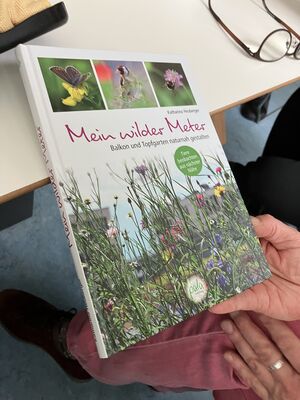Difference between revisions of "Wildecken"
| Line 1: | Line 1: | ||
| − | [[File:Book.jpg|thumb|Christine had this book, which is inspiring!]] | + | This is some information collected during [[Hackathon in Darmstadt|the Darmstadt Hackathon]] (may2023)[[File:Book.jpg|thumb|Christine had this book, which is inspiring!]] |
'''Habitats for beneficial insects - ‘Wildecken’''' | '''Habitats for beneficial insects - ‘Wildecken’''' | ||
| Line 10: | Line 10: | ||
Tall grass and shrubs help the beneficial insects survive. | Tall grass and shrubs help the beneficial insects survive. | ||
| − | Avoid pesticides!! | + | Avoid pesticides!! |
Plant nectar-rich plants (especially common for flowers with a single circle of petals). | Plant nectar-rich plants (especially common for flowers with a single circle of petals). | ||
Latest revision as of 09:18, 7 May 2023
This is some information collected during the Darmstadt Hackathon (may2023)
Habitats for beneficial insects - ‘Wildecken’
Include food, water and space,
soil to dig in, dead leaves and branches…
Make sure to also include protective plants, low to the ground.
Tall grass and shrubs help the beneficial insects survive.
Avoid pesticides!!
Plant nectar-rich plants (especially common for flowers with a single circle of petals).
Greek oregano and thyme are beacons to beneficial insects
Calendula, oregano and parsley attract hoverflies and lady bugs
Carrots, dill, asters and fennel attract for lacewing larvae.
Mulch for grand beetles that eat pest caterpillars.
Regularly refill shallow birdbaths or pans of water (with escape routes… rocks or sticks)
Finally, make sure to include plants to attract prey of the beneficial bugs help the good ones get well established.
Lebensräume für Nutzinsekten - 'Wildecken'
Dazu gehören Nahrung, Wasser und Platz,
Erde zum Graben, tote Blätter und Äste...
Achten Sie darauf, dass auch schützende, bodennahe Pflanzen vorhanden sind.
Hohes Gras und Sträucher helfen den Nützlingen zu überleben.
Vermeiden Sie Pestizide!!
Pflanzen Sie nektarreiche Pflanzen (besonders häufig bei Blüten mit einem einzigen Blütenblattkreis).
Griechischer Oregano und Thymian sind Leuchttürme für Nutzinsekten
Ringelblume, Oregano und Petersilie locken Schwebfliegen und Marienkäfer an
Möhren, Dill, Astern und Fenchel locken Florfliegenlarven an.
Mulch für Großkäfer, die Raupen von Schädlingen fressen.
Füllen Sie regelmäßig flache Vogeltränken oder Wasserschalen nach (mit Ausweichmöglichkeiten... Steine oder Stöcke)
Und schließlich sollten Sie darauf achten, dass Sie Pflanzen einsetzen, die die Beute der Nützlinge anlocken und den guten helfen, sich gut zu etablieren.
Habitats pour les insectes utiles - 'Wildecken'
Comprend de la nourriture, de l'eau et de l'espace,
de la terre pour creuser, des feuilles et des branches mortes...
Veillez à inclure également des plantes protectrices, au ras du sol.
Les herbes hautes et les arbustes aident les insectes utiles à survivre.
Évitez les pesticides !
Plantez des plantes riches en nectar (surtout les fleurs à un seul cercle de pétales).
L'origan grec et le thym sont des phares pour les insectes utiles.
Le calendula, l'origan et le persil attirent les syrphes et les coccinelles.
Les carottes, l'aneth, les asters et le fenouil attirent les larves de chrysopes.
Pailler pour attirer les grands coléoptères qui mangent les chenilles des insectes nuisibles.
Remplissez régulièrement des bains d'oiseaux peu profonds ou des bacs d'eau (avec des échappatoires... des pierres ou des bâtons).
Enfin, veillez à inclure des plantes qui attirent les proies des insectes bénéfiques et aident les bons insectes à bien s'établir.
